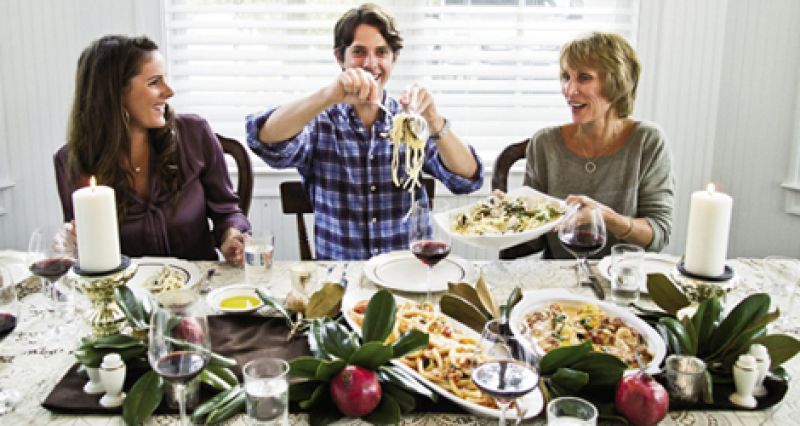
You can learn a lot about a chef by watching him cook. In the kitchen of his girlfriend’s parents’ house, Ken Vedrinski is cradling a whirring pasta machine like it’s a cello. He’s telling guests a story about sourcing the remaining bags of his favorite semolina flour from an Italian importer in New York who went out of business, while simultaneously catching the quickly emerging bucatini noodles with his left hand and swiftly cut them into 10-inch lengths with his right.
It’s obvious Vedrinski’s no stranger to the task. Still, girlfriend Sara Donahue and her mother, Cindy, can’t help but plead, “Please don’t cut yourself!” The chef just smiles and keeps the story going. “So I finally get the guy to agree to sell me his last 65 pounds of flour, but he won’t ship it!” he says, slicing through the noodles. “Lucky for me, Sara’s parents live in New Jersey, and her dad said he’d be happy to drive over an hour and a half to pick it up.”
It’s Christmas Eve, and Vedrinski is calm even though multiple dishes are coming together at the same time. The James Beard-nominated chef and owner of Trattoria Lucca is once again cooking the traditional Festa dei Sette Pesci (Feast of the Seven Fishes), this year for friends at the Donahues’ second home on John’s Island.
Vedrinski first celebrated the feast as a young man when he and his three siblings were living with their Italian grandparents in St. Petersburg, Florida. “For my family, it centered around my grandmother, who always prepared it from local seafood before Midnight Mass,” Vedrinski explains. “It was quite beautiful and exciting because our extended family and friends would come over to eat.”
The feast traditionally took place during the Vigilia di Natale in predominantly Catholic southern Italy, where meat was typically eschewed on Fridays and religious holidays and where seafood was abundant. Over time, the number (seven, nine, 13, or more) and kinds of fish dishes prepared (octopus, eel, clams, etc.) evolved from place to place and family to family.
“While my Grandma Volpe typically cooked in a rustic style, this was the one time each year when she cooked a little finer,” Vedrinski recalls. “We made lobsters, scungilli (sea whelk), things she cooked back home in Abruzzo. My grandfather gathered fiddler crabs as bait and caught sheepshead and blue crabs for the meal. That’s when I really started to appreciate seafood.”
On this day, together with Sara’s family and their guests, Vedrinski’s heritage and passion are evident in the mix of dishes he’s preparing, both old and new. The feast starts with a few antipasti, including an elegant flounder crudo; fritto misto (mixed fry) of local shrimp, oysters, and flounder dipped in a spicy agresto sauce; and a warm salad of root vegetables with a flavorful bagna cáuda (literally “hot bath”) of olive oil, butter, garlic, and anchovies.
Then there’s a pasta course. “For my family’s feast, scungilli are very traditional,” Vedrinski explains as he stirs the conch-laden sauce for the gomiti, one of three pasta dishes being prepared. “When I was in the Caribbean, we made a Bolognese out of conch. So today I’m going to cook it down like you would ground pork with tomatoes and Calabrese chilies. It makes the most beautiful sauce.”
So does the fresh tomato sugo for the blue crab- and spinach-stuffed conchiglioni (shell-shaped pasta), infused with heavy cream and baked with plenty of Parmigiano-Reggiano. “My grandmother always made stuffed shells,” Vedrinski says. “They were my favorite.” The third pasta is bucatini with Clammer Dave’s local clams dressed in a heavenly combination of goat butter and verdicchio reduction.
The piatti grande (main dishes) make their way to the table next. They include a beautifully simple picatta of local flounder served with a slightly sweet and sour tomato sauce topped with sautéed fresh rock shrimp. There’s also a scallopini of local swordfish, lightly breaded, pan-fried, and served with a pungent sweet onion fonduta and a red Lambrusco wine reduction. Both preparations allow the flavor of the fish to shine through.
“The best thing I can do to show the food the most respect is almost nothing, really,” the chef explains. “I choose fish that’s harvested in the right way, adorn it with olive oil made by someone who ensures it’s pressed and strained the right way, and add a little citrus and good quality sea salt—that’s all I do,” he says, in typically understated fashion. “In the end, I don’t want to ever have to compromise with the ingredients, and therefore with my cooking.”
As Vedrinski brings the final course to the table, a succulent apple torta made with polenta and served with homemade caramel gelato, it’s clear there’s been no compromise at this feast. The Donahues and guests evidently agree, as glasses clink and laughter echoes through the house.